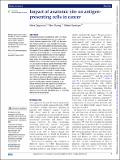Impact of anatomic site on antigen-presenting cells in cancer
Author(s)
Zagorulya, Maria; Duong, Ellen; Spranger, Stefani
DownloadPublished version (1.553Mb)
Publisher with Creative Commons License
Publisher with Creative Commons License
Creative Commons Attribution
Terms of use
Metadata
Show full item recordAbstract
<jats:p>Checkpoint blockade immunotherapy (CBT) can induce long-term clinical benefits in patients with advanced cancer; however, response rates to CBT vary by cancer type. Cancers of the skin, lung, and kidney are largely responsive to CBT, while cancers of the pancreas, ovary, breast, and metastatic lesions to the liver respond poorly. The impact of tissue-resident immune cells on antitumor immunity is an emerging area of investigation. Recent evidence indicates that antitumor immune responses and efficacy of CBT depend on the tissue site of the tumor lesion. As myeloid cells are predominantly tissue-resident and can shape tumor-reactive T cell responses, it is conceivable that tissue-specific differences in their function underlie the tissue-site-dependent variability in CBT responses. Understanding the roles of tissue-specific myeloid cells in antitumor immunity can open new avenues for treatment design. In this review, we discuss the roles of tissue-specific antigen-presenting cells (APCs) in governing antitumor immune responses, with a particular focus on the contributions of tissue-specific dendritic cells. Using the framework of the Cancer-Immunity Cycle, we examine the contributions of tissue-specific APC in CBT-sensitive and CBT-resistant carcinomas, highlight how these cells can be therapeutically modulated, and identify gaps in knowledge that remain to be addressed.</jats:p>
Date issued
2020Department
Massachusetts Institute of Technology. Department of BiologyJournal
Journal for ImmunoTherapy of Cancer
Publisher
BMJ
Citation
Zagorulya, Maria, Duong, Ellen and Spranger, Stefani. 2020. "Impact of anatomic site on antigen-presenting cells in cancer." Journal for ImmunoTherapy of Cancer, 8 (2).
Version: Final published version